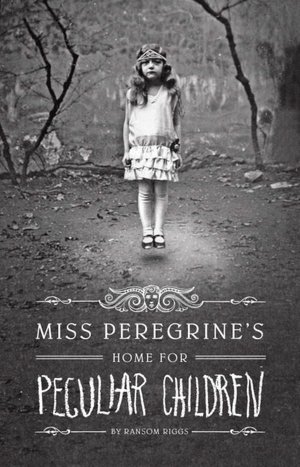Audience: Upper High School, 16+
Genre: Fantasy, Biomythography, Realistic Horror, Crossover YA/Adult
Topics of Focus: Dreams, Time travel, Normality, Family
Red Flags: May be too dark for a younger audience.
One should not judge a book by its cover, but I certainly did with Riggs’s first novel, Miss Peregrine’s Home for Peculiar Children. The little, levitating girl on the front jacket cover looked strange, grotesque, eerie, and yes, peculiar. The images on the back jacket were reminiscent of a David Lynch movie or that weird bear scene in Kubrick’s The Shining. Now that’s the kind of stuff worth reading! Like the bogs of Wales, this one draws you in slowly, but surely.
In his first full novel, Ransom Riggs presents a creative world of family secrets, time travel, the magical possibility of physics, dark shadows, and realistic doubt of what we understand the world and its strange history to be. When I first picked up the book, I had high hopes. I wanted weird stuff to match those peculiar illustrations that pulled me toward the book in the first place. I was introduced to Jacob “Jake” Portman, a somewhat spoiled and rather boring sixteen-year-old relating the disappointments of a failure father, a money-laden matriarchal side of the family, and the quirky vague stories of an aging grandfather flirting with dementia. What? The book was just a plain old memoir where the writer learns there is little more to life than the mundane and we have to let our imaginations make up the rest. Why on earth is this book so popular? What was the deal with the illustrations and its creepy promise? I kept reading, opening my realistic mind, trusting that there had to be deeper metaphors to resurrect. The author came through for me.
In the aftermath of a gruesome lethal attack in his back yard, the grandfather’s dying words instruct our narrator to “Go to the island…Find the bird. In the loop. On the other side of the old man’s grave. September third, 1940” (32-33). Jake holds his dying grandfather in the shadow of something straight out of an H.P. Lovecraft story. The memory haunts him, and Jake is mired in endless rounds of therapy. As part of his family’s grieving process, Jake assists in clearing out his grandfather’s personal possessions. Stories are shared. A letter from a mysterious woman uncovered. Disconnected puzzle pieces arise in the shapes of Cairnholm Island (Wales), a fledgling war against Nazi monsters, a safe place for orphans of the war, and a headmistress named Alma LeFay Peregrine. Questions arise as to what was truth, deception, or pure fantasy in the tales of the now-dead patriarch. Jake must find the answers. He convinces his father to accompany him to Cairnholm, a place known for little more than its quicksandesque bogs. Like those bogs, the rest of the story, shrouded in a thick fog of the strange and grotesque, sucks you in until you are held firm to a wonderful closure full of imaginative possibility.
Riggs is a master of deception in this tale. What appears as the mundane actually offers hints of mystery and clues of the bigger picture revealed at its close. He allows the cadence of his prose to mirror the mystery presented to and anxiety felt by the narrator. The reader plods through the bogs along with Jacob as the story takes you deeper into the secrets of Cairnholm and Miss Peregrine’s orphans. It then picks up speed as knowledge and understanding of the truth push the story forward. Yes, there are some parts that seem a little too fantastical and even a bit Indiana Jones-like for the modern reader, but they are appropriately presented as the possibilities of time loops and the physics of history are revealed.
This text would be highly useful to teachers of creative writing. It will appeal to those who are interested in fantasy, horror, memoirs, photography, and the down-right-strange. Its comprehension level is moderate and vocabulary/sentence structure somewhat challenging, yet the prose is approachable for a strong younger reader or a moderate reader sixteen or older. The photograph illustrations are well-done and complement the story.
Read it, or you will be sorry! Don’t wait for the movie.
Annotation by Denise Aulik

No comments:
Post a Comment